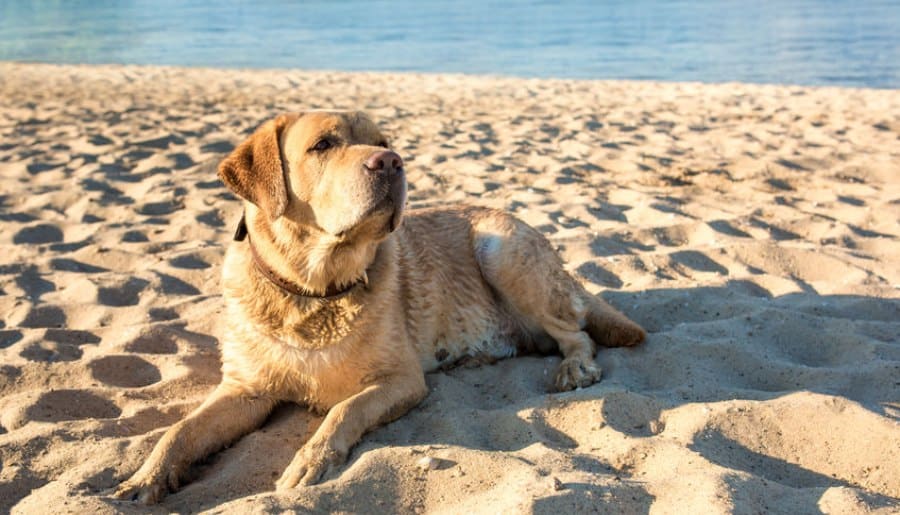
As many of you will already know, the Labrador is a water dog. Not only does this make them naturally adept at retrieving dead ducks, but it also makes them the ideal pet for a day at the beach. We have put this article together to give Labrador owners like you a few tips to help create the perfect day at the beach.
So what is the goal here? When taking your dog to the beach, it is important to strike a balance between fun and control. You want you and your dog to have a good time, but you don’t want them to get into trouble in the process.
The last thing you want is some kind of mistake ruining your pleasant beach vacation. Read on, and get a few tips from the experts about how to treat your dog (and yourself) to the kind of trip that you both deserve.
1. Make sure that the beach allows dogs
Before you even start planning your trip to the beach, you need to call the beach authorities ahead of time and make sure that dogs are allowed on that particular beach. There are quite a few beaches that have banned dogs completely, due to frequent issues with irresponsible owners who don’t want to control their animals. Those that do allow dogs will normally have some restrictions such as requiring them to be on a leash or only allowing them at certain times of the day. Make sure you do your homework so that your trip doesn’t get ruined at the last minute!
2. Take lots of fresh water and make sure they drink it
All humans know that it’s a bad idea to drink seawater. However, dogs are not necessarily aware of this fact. After all, they are famous for drinking out of toilet bowls. Although small amounts will not harm them, your dog could run into trouble if they drink a large amount of seawater. It could cause vomiting and diarrhea and could even pose a serious risk if they drink a huge amount. You can remedy this by bringing plenty of fresh water and offering it to your dog at frequent intervals. Since the dog is likely to be very active, it’s a good idea to keep them hydrated anyway.
3. Bring bags and a scoop to clean up any messes your dog may leave
This one is just a matter of common courtesy. Chances are, your dog will have to relieve themselves at some point during this little excursion. So, don’t be inconsiderate and just leave a stinking pile of fecal matter on the sand. The chances are good that someone will step in it, and that’s no fun at all. It is also disgusting for anyone who might be swimming nearby, as it fouls the water. Bring some small bags and a slotted scoop so that you can dispose of any nasty little surprises. As you use the slotted scoop, you can get a taste of how cat owners feel when they clean the litter box.
4. Don’t go at or around noon
The beach is a lot of fun, but it’s also pretty hot. Sunstroke and sunburn are two things that you have to consider. As you probably know, Labs tend to be very energetic. As you also know, they love water. These two factors can combine with a very hot day to produce some serious heat exhaustion. Therefore, it is best to avoid the beach during the hottest hours of the day, when the sun is directly overhead and therefore at its harshest. If you must be on the beach at this time, spend an hour or two on the blankets! .your feet and your skin will thank you later.
5. Don’t let your dog go in the deep water
Labradors may love the water, but they aren’t creatures of the sea. As such, you really don’t want your dog to go very far from the beach. There are multiple reasons for this. The most obvious is the threat of drowning, which can easily happen if the dog tires itself out. A Lab does swim better than most dogs, but they have limits to their energy just like anything else. The other obvious threat is predation. Sharks and other creatures will most certainly prey upon dogs, and once they get far away from the shore, the danger is increased greatly. You can remedy this with a long leash that will allow them to swim freely without going too far.
6. Don’t force the dog to go into the water
Most of the time, A Labrador will bound into the water with little to no encouragement. If anything, you might have a hard time keeping them away from the water, as their every instinct pulls them toward it. However, some dogs just don’t like the ocean. If your Lab has only swum in ponds or small lakes, the sight of the ocean might be a little bit too intimidating for them. If your dog is hesitant to get into the ocean, don’t try to push them or pull them. Let them do it at their own pace.
7. Watch out for hot sand
One danger you may not have thought about is hot sand. During the heat of the day, beach sand can pose a serious burn hazard to the sensitive undersides of a dog’s paw. You will need to protect their paws from the hot sand, especially if you plan to spend all day at the beach. There are two popular ways to do this. The first is to buy or make a set of dog socks. You can just buy baby socks and cut holes for the claws to poke through. The other method is to buy “paw wax,” which is exactly what it sounds like.
8. Provide plenty of shade:
We have already talked about the dangers of excessive sunlight, so there is no need to repeat ourselves. Suffice it to say that the best way of dealing with this problem is a nice big beach umbrella. You could also buy one of those folding canopies, but they tend to be somewhat fragile. Either way, you need to make sure that you and your dog have a place to get out of the sun.
9. Use sunscreen
Being a short-haired dog, the Labrador is especially vulnerable to sunburn. If your Lab happens to be a yellow Lab, this is even truer. Your dog won’t enjoy a sunburn any more than you do. One of the best ways to deal with this is through the use of sunscreen. Make sure you buy one that is specifically intended for dogs. Make sure that you never put human sunscreen on a dog, as their skin has different sensitivities as compared to ours.
10. Consider a monitoring device:
Despite your best efforts, there is always a chance that your dog will get loose and go missing. If this should occur, the use of a GPS tracking device can be a good way to find them. These devices can be worn on the collar, or you can go a little farther and have your dog “chipped” with a locator beacon. Obviously, any device you use will need to be thoroughly waterproof. Some vendors offer special dog harnesses with a built-in GPS, and these are normally the best way to go. A collar can be removed much more easily than a harness, especially for a large-headed dog like a Labrador.
11. Don’t just let the dog run loose
Don’t be one of those people that allows their dog to run loose and annoy others. While you may find your dog to be irresistibly cute, others may well find them to be a nuisance. Some people will also react with fear-based aggression if they see a strange dog walking around. This can create unpleasant situations, to say the least. On top of that, there are people who steal dogs, and others who torture and kill them just for fun. This is a horrible fact of life, but it is important for every dog owner to understand that “stranger danger” applies just as much to dogs as it does to children.
12. Try to go at low tide
When you take a trip to the beach, you want to play in the sand. You want to play in the surf. Chances are, your dog feels more or less the same way. So don’t go when the tide is high, as most of the beach will be underwater. Most areas have tide advisories that you can consult to see approximately what times the tides will normally turn. Also, low tide tends to mean weaker currents, which is good from a safety perspective.
13. Keep your eye out for dangerous waste
People have found a lot of strange things washed up on the beach. There are all kinds of websites that offer a list of the top ten weirdest things found on the beach. Take a look at some of these and ask yourself: Would I want my dog messing with that? People have found medical waste, human remains, poisonous sea creatures, old fish hooks, and all sorts of things. Then, of course, you have all the normal human waste like broken glass, bits of metal, and various chemicals. Do your best to be on the lookout for anything that may hurt your dog.
14. Bring treats and toys
Your Lab needs something to do on the beach, just like you do. While they can be perfectly happy with just playing in the water, it is good to bring along various toys to keep the dog entertained. Give them an outlet for all that energy and excitement so that they will be less likely to get into trouble. As for treats, these provide a ready-made way to bring the dog under control in a hurry if it turns out to be necessary. Besides, you may want to show off the tricks that your dog can do. Even if your dog doesn’t do any tricks, it is still a good idea to remind them that you are the master and provider. A treat is a good way to reinforce that notion, as long as it is earned. As I always say, If you reward your dog for doing nothing, you are teaching him to do nothing. Make them earn their milk bones and rawhides!
15. Bring a medkit
You really should try to keep a small medical kit in your vehicle at all times. If you enjoy taking your dog out for extended trips, you must pack your medical kit with the appropriate items. Many of the same first-aid items that work on humans can work on a dog, such as bandages and antiseptics. However, you don’t want to give them any medicines that are not specifically intended for them. Consult with your veterinarian for advice on exactly what your dog is likely to need.
16. Consider a flotation device and/or earplugs
Although Labradors are born and bred for the water, it can still present certain hazards to them. If your dog is not a particularly strong swimmer, or if you just want to make it easy for him, consider the purchase of a flotation vest aka a life jacket. These are available for purchase, and could probably be improvised with a dog harness and a couple of pool noodles. Just make sure the noodle pieces are completely enclosed in the fabric so that they cannot separate and float away. Earplugs may or may not be required, but excessive salt water in the ear canal of any creature can cause problems. As such, many dog owners will buy their dog a set of earplugs to keep seawater from damaging their sensitive hearing organs.
17. Make sure vaccinations are up to date
When you are taking an animal into a public space, there is always the possibility that a problem will occur. Of course, we humans cannot criticize too harshly here, because we also often tend to get ourselves into trouble. Should an incident occur, whether its a person being bitten or a fight with another dog or some kind of medical emergency, proper vaccinations can make a big difference in how the situation is handled. On top of that, you also never know what kind of microbes your dog might be exposed to in this public space. If your dog should happen to encounter another dog that is carrying a disease, for instance, proper vaccination could mean the difference between life and death.
18. Don’t let them overexercise
As everyone knows, the Labrador is a very energetic dog that is known for its tendency to work until it drops. So remember; the Labrador works hard and plays hard too. If you don’t keep a handle on them, they can easily overexert themselves. Remember, your animal is here to have fun like you, so try not to let them wear themselves out.
19. Look out for other dogs
Just as you enjoy taking your dog to the beach, many other beach-goers do as well. So, you have to be careful about exposing your dog to others. Honestly, interactions between canines are difficult to predict. As a general rule, two male dogs are much more likely to fight than two females, or a mixed meeting. If your dog is a female, you should make sure that she isn’t in heat, or you will spend half your day chasing off horny male dogs.
20. Bathe well upon returning
As stated before, public spaces are inherently dirty. You wouldn’t eat from the counter of your local bar, would you? I hope not. Yeah, I know they wipe it down with a rag but who knows how often or how seldom they wash that rag? In like manner, you shouldn’t be bringing the beach home with you. Try to brush the sand out of your dog’s coat as best you can, and be sure to give them a good bath immediately upon returning.
Related Questions:
How often do sharks actually eat dogs?
Most of the time, sharks will avoid the shallow area of a crowded beach. Thus, the chances of a shark attack are low unless your dog swims pretty far. However, there is no doubt that virtually any shark will take a dog if given the opportunity.
How toxic is saltwater?
Saltwater is not particularly toxic. A person can drink a certain amount of it with no ill effects, and for a dog, it is pretty much the same. Large amounts of saltwater, however, have been fatal in certain cases.
Should I put a muzzle on my dog for a day at the beach?
In a word, no. If your dog is aggressive enough to require a muzzle, the beach is probably not the best place to take them. There are simply too many other people and other dogs to take such a gamble. Besides, the sight of a muzzled dog will frighten people.



